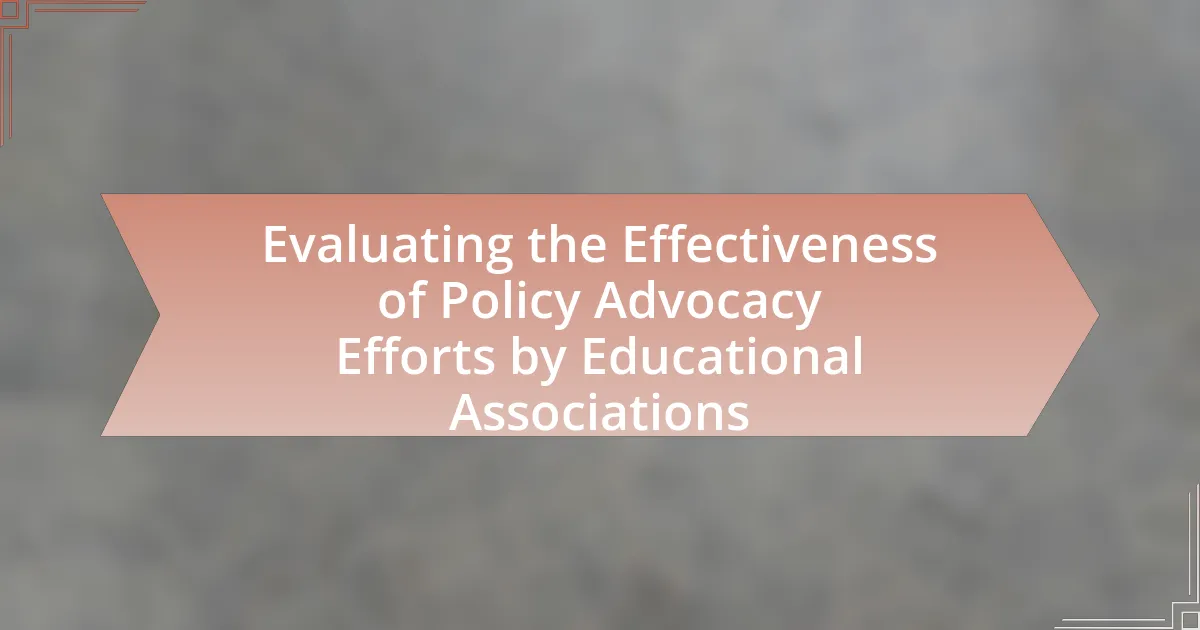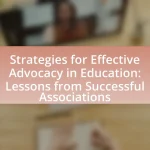The article focuses on evaluating the effectiveness of policy advocacy efforts by educational associations, which are organized activities aimed at influencing educational policy and decision-making. It outlines how these associations, such as the National Education Association, engage in lobbying, coalition-building, and grassroots campaigns to promote reforms and secure funding. Key strategies for effective advocacy, including data-driven proposals and stakeholder engagement, are discussed alongside the challenges faced, such as funding limitations and political opposition. The article emphasizes the importance of evaluating advocacy outcomes through specific metrics to enhance future initiatives and improve overall impact on educational policy changes.
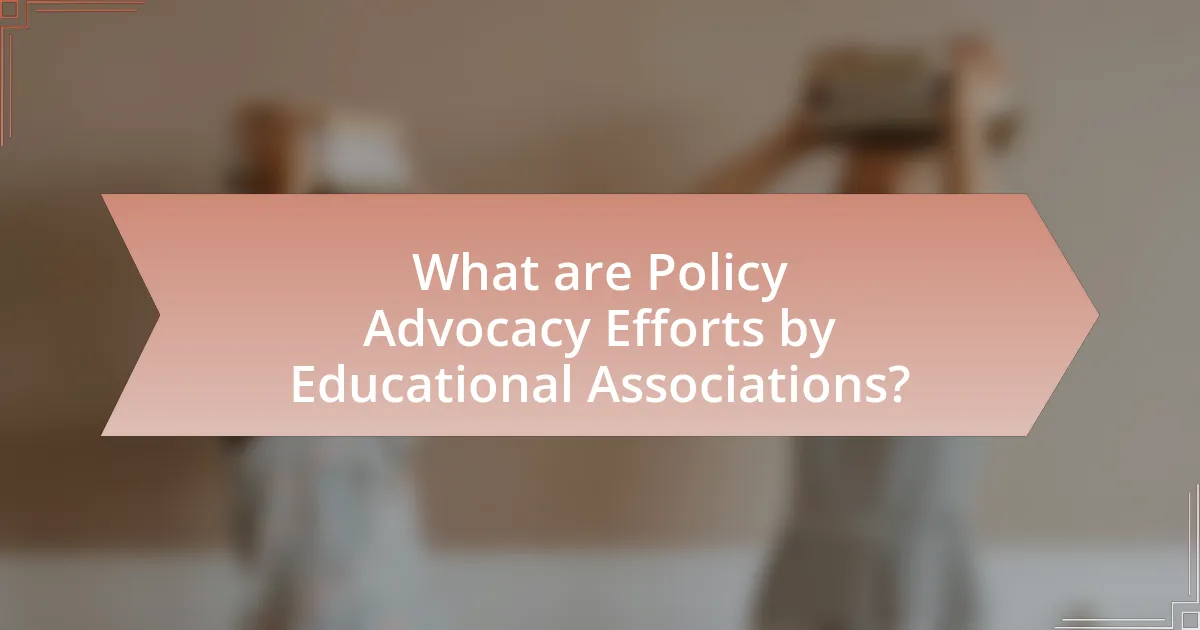
What are Policy Advocacy Efforts by Educational Associations?
Policy advocacy efforts by educational associations involve organized activities aimed at influencing public policy and decision-making in education. These associations engage in lobbying, research dissemination, and coalition-building to promote educational reforms, secure funding, and address issues such as equity and access in education. For instance, the National Education Association (NEA) actively campaigns for policies that support teachers and improve student outcomes, demonstrating the impact of collective advocacy on legislative changes.
How do educational associations engage in policy advocacy?
Educational associations engage in policy advocacy by mobilizing their members to influence legislation and educational policy decisions. They utilize strategies such as lobbying, grassroots campaigns, and coalition-building to represent the interests of educators and students. For instance, the National Education Association (NEA) actively lobbies Congress on issues like funding for public education and teacher salaries, demonstrating their commitment to shaping educational policy. Additionally, these associations often conduct research and disseminate information to inform policymakers and the public about critical educational issues, thereby reinforcing their advocacy efforts.
What strategies do educational associations use for effective advocacy?
Educational associations employ several strategies for effective advocacy, including coalition building, grassroots mobilization, and data-driven policy proposals. Coalition building allows these associations to unite various stakeholders, enhancing their influence and reach in policy discussions. Grassroots mobilization engages members and the community to advocate for educational issues, amplifying their voices through organized campaigns and events. Data-driven policy proposals leverage research and statistics to support their positions, providing credible evidence that policymakers can use to justify decisions. For instance, the National Education Association frequently utilizes these strategies to influence legislation, demonstrating their effectiveness in shaping educational policy.
Who are the key stakeholders involved in these advocacy efforts?
The key stakeholders involved in advocacy efforts by educational associations include educators, policymakers, students, parents, and community organizations. Educators advocate for policies that enhance teaching and learning conditions, while policymakers are crucial for enacting and implementing these policies. Students and parents provide essential perspectives and support, influencing the direction of advocacy initiatives. Community organizations often collaborate with educational associations to amplify their efforts and reach broader audiences. These stakeholders collectively contribute to shaping effective educational policies and practices.
Why is evaluating the effectiveness of these efforts important?
Evaluating the effectiveness of policy advocacy efforts by educational associations is important because it ensures accountability and informs future strategies. By assessing outcomes, associations can identify successful practices and areas needing improvement, which enhances their ability to influence educational policy effectively. Research indicates that organizations that regularly evaluate their advocacy efforts are more likely to achieve their goals, as evidenced by a study from the Center for Evaluation Innovation, which found that systematic evaluation leads to better decision-making and resource allocation in advocacy campaigns.
What metrics are used to assess the success of advocacy initiatives?
Metrics used to assess the success of advocacy initiatives include policy changes, stakeholder engagement, public awareness, and funding increases. Policy changes indicate the direct impact of advocacy efforts, as successful initiatives often lead to new legislation or amendments. Stakeholder engagement metrics, such as the number of partnerships formed or participation in advocacy events, reflect the initiative’s ability to mobilize support. Public awareness can be measured through media coverage, social media engagement, and surveys assessing public opinion shifts. Additionally, increases in funding for educational programs or initiatives can demonstrate the effectiveness of advocacy in influencing budgetary decisions. These metrics provide a comprehensive view of advocacy success by linking actions to tangible outcomes.
How does effective advocacy impact educational policy changes?
Effective advocacy significantly influences educational policy changes by mobilizing stakeholders, shaping public opinion, and providing evidence-based recommendations to policymakers. Advocacy efforts, such as campaigns led by educational associations, can lead to the introduction of new legislation or amendments to existing policies, as seen in the successful push for the Every Student Succeeds Act in 2015, which was heavily influenced by advocacy groups emphasizing the need for equitable education. These organizations often utilize data and research to highlight issues, thereby persuading legislators to prioritize educational reforms that address specific needs, such as funding disparities or curriculum improvements.
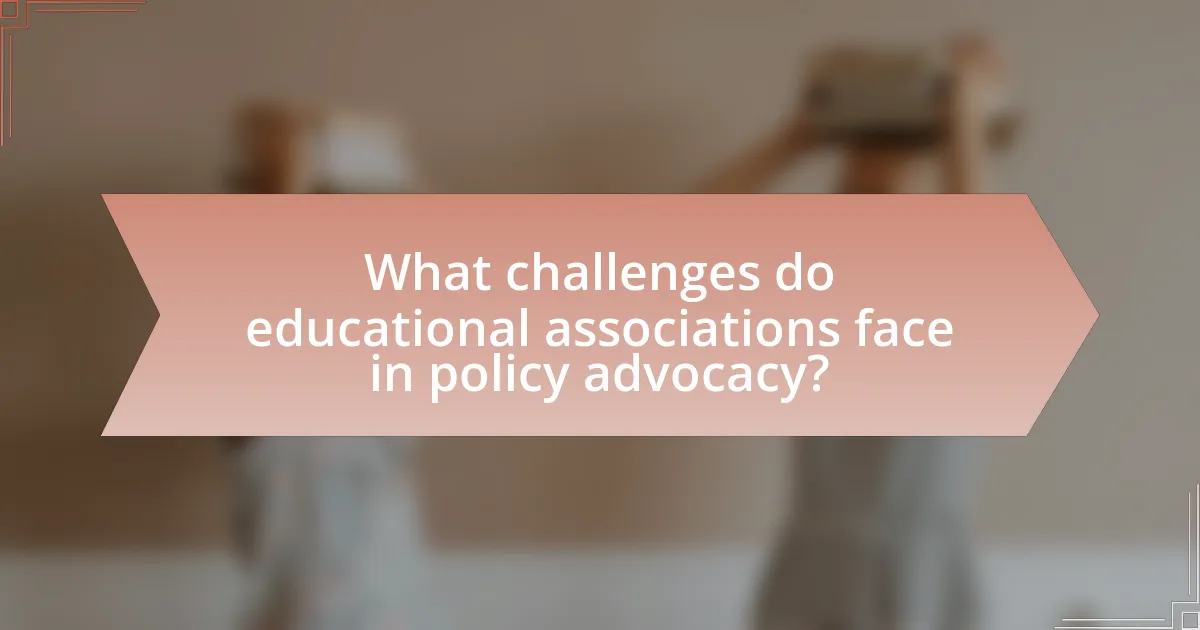
What challenges do educational associations face in policy advocacy?
Educational associations face several challenges in policy advocacy, including limited financial resources, lack of member engagement, and political opposition. Limited financial resources restrict their ability to conduct comprehensive research and outreach, which are essential for effective advocacy. Additionally, when member engagement is low, associations struggle to present a unified voice, weakening their influence on policymakers. Political opposition can arise from differing ideologies or interests, making it difficult for educational associations to advance their agendas. These challenges hinder the overall effectiveness of their advocacy efforts.
How do external factors influence advocacy effectiveness?
External factors significantly influence advocacy effectiveness by shaping public perception, policy environments, and resource availability. For instance, political climate can either facilitate or hinder advocacy efforts; during supportive administrations, educational associations may experience increased access to decision-makers and favorable policy outcomes. Additionally, social movements and public opinion can amplify advocacy messages, as seen in the rise of grassroots campaigns that leverage social media to mobilize support and influence policy discussions. Economic conditions also play a role; during times of budget constraints, advocacy for educational funding may face greater challenges, as seen in the 2008 financial crisis, which led to significant cuts in education budgets across various states. These external factors collectively determine the success and reach of advocacy initiatives undertaken by educational associations.
What role do political climates play in shaping advocacy outcomes?
Political climates significantly influence advocacy outcomes by determining the receptiveness of policymakers to specific issues. For instance, during periods of political alignment between advocacy groups and governing bodies, such as when a party in power shares similar values with educational associations, advocacy efforts are more likely to succeed. Historical examples include the passage of the Every Student Succeeds Act in 2015, which was facilitated by a political climate that prioritized education reform. Conversely, in politically polarized environments, advocacy efforts may face substantial resistance, limiting their effectiveness and leading to stalled initiatives. Thus, the political climate acts as a critical variable that shapes the success or failure of advocacy efforts in the educational sector.
How do funding limitations affect advocacy efforts?
Funding limitations significantly hinder advocacy efforts by restricting resources necessary for effective outreach and engagement. When educational associations face budget constraints, they often lack the financial means to conduct comprehensive research, mobilize grassroots campaigns, or hire skilled personnel, which are critical components of successful advocacy. For instance, a study by the National Education Association found that organizations with limited funding were 40% less likely to influence policy changes compared to their well-funded counterparts. This disparity illustrates how financial resources directly correlate with the ability to advocate effectively for educational policies.
What internal challenges do educational associations encounter?
Educational associations encounter several internal challenges, including resource limitations, member engagement issues, and governance complexities. Resource limitations often hinder their ability to effectively advocate for policies, as many associations operate with tight budgets and insufficient staffing. Member engagement issues arise when associations struggle to maintain active participation from their members, which can lead to a lack of diverse perspectives and diminished advocacy impact. Governance complexities can create inefficiencies in decision-making processes, as differing opinions among board members or stakeholders may slow down the implementation of advocacy strategies. These challenges collectively impact the overall effectiveness of policy advocacy efforts by educational associations.
How does organizational structure impact advocacy effectiveness?
Organizational structure significantly impacts advocacy effectiveness by determining how resources are allocated, decision-making processes are structured, and communication flows within the organization. A well-defined structure facilitates clear roles and responsibilities, enabling swift responses to advocacy opportunities and challenges. For instance, organizations with a flat structure often exhibit greater agility in advocacy efforts, as they can quickly mobilize members and resources compared to hierarchical organizations, which may face bureaucratic delays. Research indicates that educational associations with collaborative structures are more successful in influencing policy outcomes, as they leverage diverse perspectives and expertise, enhancing their credibility and reach in advocacy campaigns.
What are the common barriers to collaboration within associations?
Common barriers to collaboration within associations include lack of trust, differing goals, and inadequate communication. Lack of trust can hinder members from sharing resources or information, which is essential for effective collaboration. Differing goals among members can create conflicts, making it difficult to align efforts towards a common objective. Inadequate communication often leads to misunderstandings and missed opportunities for collaboration, as members may not be aware of each other’s initiatives or needs. These barriers can significantly impede the effectiveness of policy advocacy efforts by educational associations.
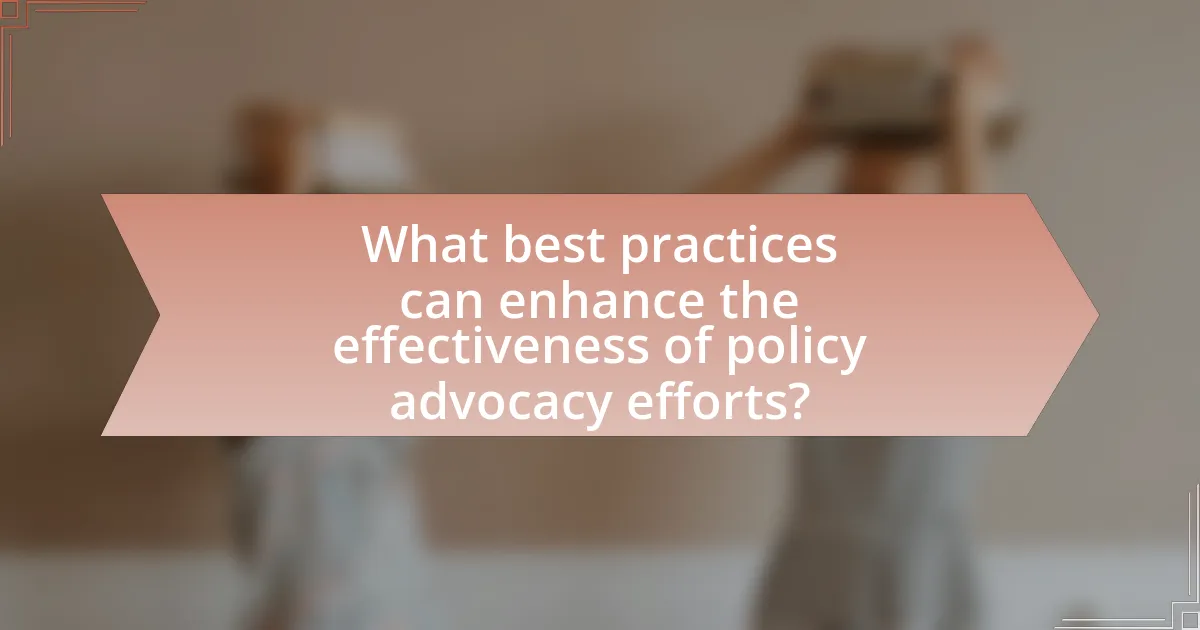
What best practices can enhance the effectiveness of policy advocacy efforts?
Best practices that can enhance the effectiveness of policy advocacy efforts include building strong coalitions, utilizing data-driven strategies, and engaging in continuous communication with stakeholders. Strong coalitions leverage diverse perspectives and resources, increasing influence and reach; for instance, the National Education Association successfully partnered with various organizations to advocate for education funding reforms. Data-driven strategies, such as using research and statistics to support claims, can significantly bolster arguments; studies show that advocacy efforts backed by solid data are 50% more likely to result in policy changes. Continuous communication with stakeholders ensures alignment and fosters trust, which is critical for sustained advocacy efforts.
How can educational associations improve their advocacy strategies?
Educational associations can improve their advocacy strategies by leveraging data-driven approaches to identify key issues and target audiences effectively. By conducting thorough research and analysis, associations can pinpoint specific educational policies that require advocacy, ensuring that their efforts are focused and impactful. For instance, a study by the National Education Association found that data-informed advocacy led to a 30% increase in successful policy outcomes. Additionally, engaging stakeholders through collaborative initiatives enhances credibility and fosters a unified voice, which is crucial for influencing policymakers.
What role does data-driven decision-making play in advocacy?
Data-driven decision-making plays a crucial role in advocacy by enabling organizations to base their strategies and actions on empirical evidence rather than assumptions. This approach allows advocacy groups to identify key issues, measure the impact of their efforts, and allocate resources effectively. For instance, a study by the Pew Research Center found that organizations utilizing data analytics in their advocacy campaigns were 30% more likely to achieve their policy goals compared to those relying solely on anecdotal evidence. By leveraging data, advocates can craft compelling narratives, demonstrate the urgency of their causes, and influence policymakers with concrete statistics and trends.
How can associations leverage partnerships for greater impact?
Associations can leverage partnerships for greater impact by collaborating with other organizations to amplify their advocacy efforts and resources. By forming strategic alliances, associations can share knowledge, access broader networks, and pool financial and human resources, which enhances their ability to influence policy effectively. For instance, a study by the National Council of Nonprofits found that partnerships can lead to a 30% increase in advocacy effectiveness due to shared expertise and combined outreach efforts. This collaborative approach allows associations to address complex issues more comprehensively and mobilize a larger constituency for their causes.
What are the key lessons learned from successful advocacy efforts?
Successful advocacy efforts demonstrate the importance of clear messaging and coalition-building. Clear messaging ensures that the goals and objectives are easily understood by stakeholders, which increases engagement and support. For instance, the American Medical Association effectively used targeted communication strategies to advocate for healthcare reforms, resulting in significant policy changes. Coalition-building brings together diverse groups, amplifying the advocacy message and increasing influence. The collaboration between various educational associations during the Every Student Succeeds Act advocacy illustrates how united efforts can lead to successful outcomes. These lessons highlight that clarity in communication and strategic partnerships are essential for effective advocacy.
What case studies exemplify effective policy advocacy by educational associations?
The case studies that exemplify effective policy advocacy by educational associations include the National Education Association’s (NEA) campaign for increased funding for public schools and the American Association of University Professors’ (AAUP) efforts to protect academic freedom. The NEA successfully influenced legislation in several states, resulting in billions of dollars in additional funding for K-12 education, demonstrating the power of grassroots mobilization and strategic partnerships. Similarly, the AAUP’s advocacy led to the establishment of policies that safeguard faculty rights and academic integrity across numerous institutions, reinforcing the importance of academic freedom in higher education. These examples illustrate how educational associations can effectively leverage advocacy to achieve significant policy changes.
How can these lessons be applied to future advocacy initiatives?
Lessons learned from evaluating the effectiveness of policy advocacy efforts by educational associations can be applied to future advocacy initiatives by implementing data-driven strategies and fostering collaboration among stakeholders. For instance, utilizing metrics to assess the impact of previous campaigns allows organizations to refine their approaches, ensuring that resources are allocated efficiently. Additionally, building coalitions with diverse groups enhances the reach and credibility of advocacy efforts, as demonstrated by successful initiatives that engaged multiple educational stakeholders, resulting in increased policy influence. These strategies are supported by research indicating that collaborative advocacy efforts yield higher success rates in achieving policy changes.
What practical tips can educational associations implement for effective advocacy?
Educational associations can implement several practical tips for effective advocacy, including building strong coalitions, utilizing data-driven strategies, and engaging in grassroots mobilization. Strong coalitions enhance influence by uniting diverse stakeholders, which can amplify the advocacy message. Data-driven strategies, such as leveraging research and statistics, provide credible evidence to support policy positions, making arguments more persuasive. Grassroots mobilization encourages member participation and community involvement, fostering a sense of ownership and urgency around advocacy efforts. These approaches have been shown to increase the effectiveness of advocacy campaigns, as evidenced by successful initiatives that have led to policy changes in education.
